Hallstattats are Europeans of the Iron Age. Ancient graves tell (part 2)
Vicks (Celtic Necropolis) is located in the French village of Vicks in the north of Burgundy. This is a very important prehistoric burial complex of the late Hallstatt and early Late times. It was a large fortified settlement and in addition also several mounds. And in one of them was found the burial of the "Lady of Viks", dated approximately 500 BC. er And it is very important that this grave was not robbed and reached our days safe and sound. It was found just amazing by the wealth of finds, including a lot of jewelry and - most importantly - the unique “crater from Weeks”, which today is the largest of the known vessels of ancient time (height 1,63 m).
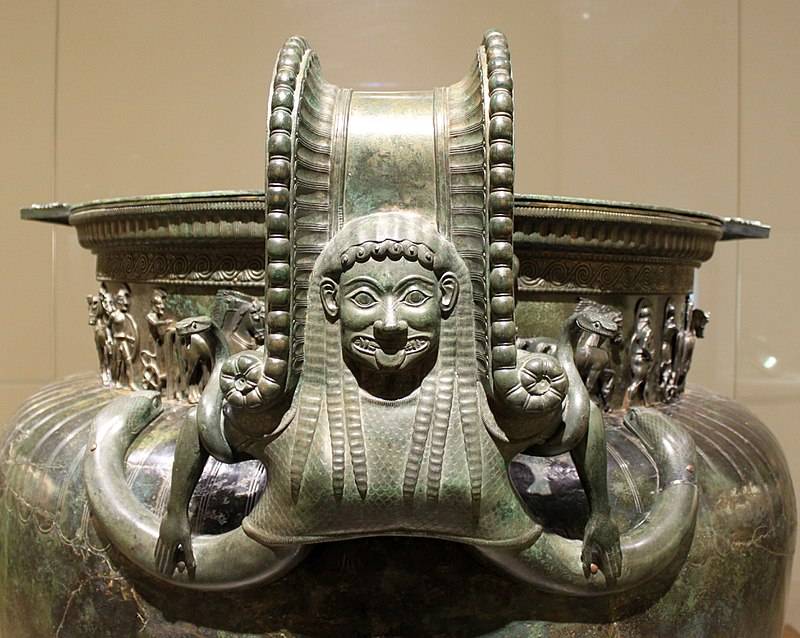
One of the most spectacular handles of the crater from Viks (Museum in Chatillon-sur-Seine, Burgundy, France)
The complex is located in the center of a steep flat-topped hill on the site of an ancient fortified Celtic settlement. The total area of the necropolis in this area is 42 ha. And all his burials belong to the Late Bronze Age (Hallstatt culture until the end of the Late time). In the VI and V centuries. BC. there was also a settlement, which was located on a fertile plain and also became an important river and land transport hub of Northern Europe.
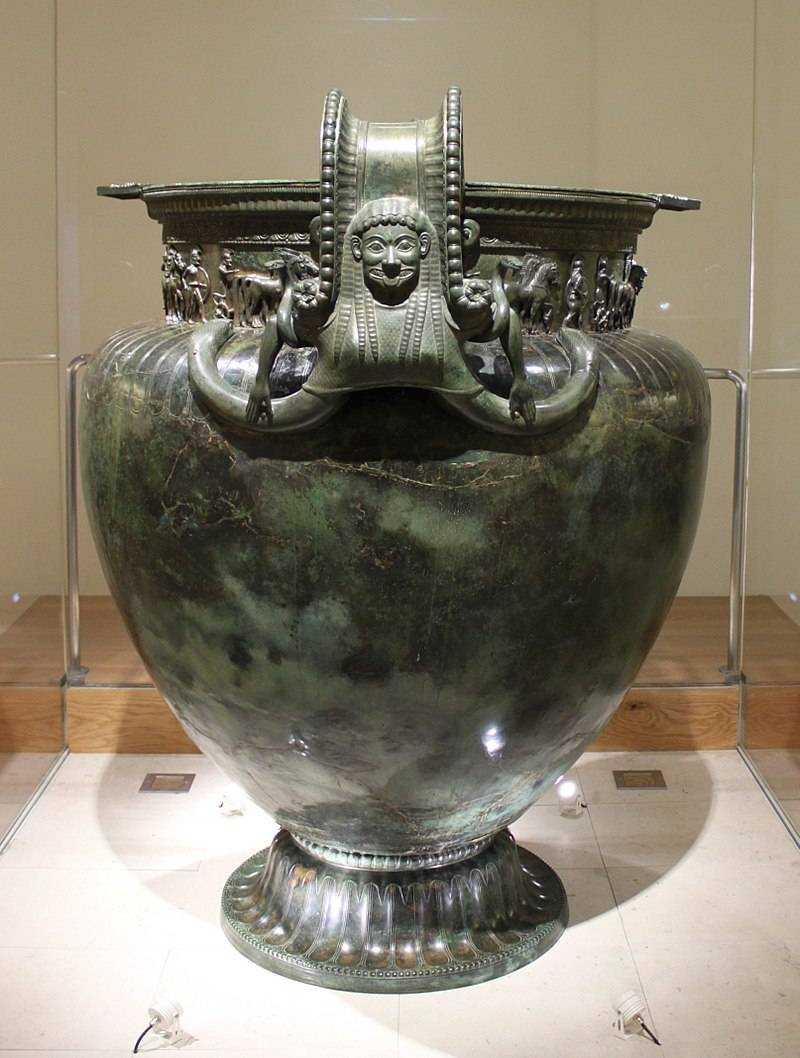
"Crater from Vicks" (Museum in Chatillon-sur-Seine, Burgundy, France)
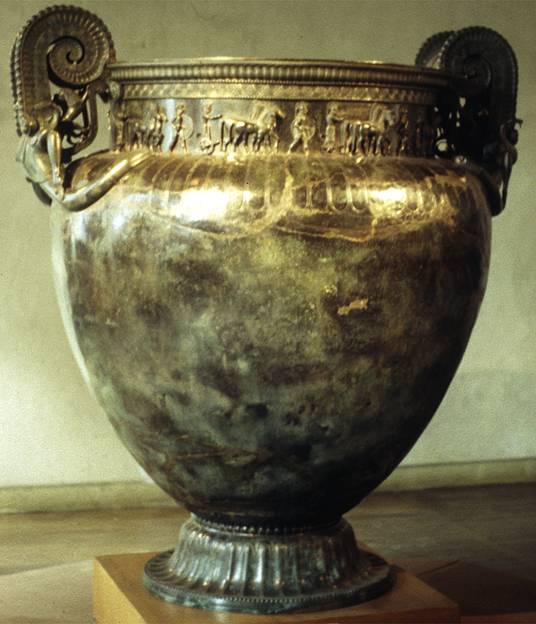
The same boat. View of the frieze.
They began to dig here from April 1930, and dug both professionals and amateurs. Found a lot of ceramic shards (today recorded more than 40 thousand units), various brooches and various products made of bronze and iron. But the mound itself with the burial of the "ladies" was excavated only in 1953 year. And there, in addition to all other finds, a unique crater was discovered - a wine vessel made by Spartan craftsmen. Apparently, this impressive piece of art impressed the contemporaries of the “Lady of Viks”, who did not spare such a valuable funeral gift for her. After this, excavations in the Vicks area went both into the 90s and after the 2001 of the year. In a word, no matter how hard they try, they still cannot dig up “everything” there. Apparently, people lived in this place for a long time and many left their “tracks” here.
For example, the remains of fortifications, ditches and walls up to 8 m thick were found on the mountain Lassua adjacent to the burial site. Found here were also houses with hearths and various household buildings. In a word, it was really a very large and well fortified settlement of the Bronze and Metal Epoch.
The excavations of 2006 of the year have been particularly successful. A whole complex of several buildings was discovered, the largest of which had a length of 35 m and a width of 21 m, with a ceiling height of 12 m. Most importantly, this find has no analogues in the culture of early Celtic Europe. Archaeologists have called this building "Palace of the Mistress of Vicks." Well, there were so many shards found that it clearly indicates that this place was a populated place, whose inhabitants traded with remote areas, for example, Greece, because fragments of characteristic black-figure vases were found here. Although they could get here from the south of France, where there were Greek colonies. Especially a lot of fragments of amphorae for wine. Apparently, the inhabitants of this settlement loved Greek wine, and it was here that they transported it to them in these amphoras.
Reconstruction of “waggons from Vicks” (Museum in Chatillon-sur-Seine, Burgundy, France)
They found a lot of jewelry: brooches, and decorated with amber or even coral, as well as earrings, beads, rings and bracelets. That is, the locals loved to decorate themselves and did not spare funds for the purchase (or manufacture) of jewelry! They also found glassware and small statues of bronze, most likely the works of Greek masters from the colonies along the shores of the Mediterranean. But from weapons mostly come across arrowheads and spears and more axes.
That is, the settlement on Mount Lassua clearly had a very high status. This is proved by the level of its fortification, the presence of the citadel and the lower town lying at the foot of the mountain, as well as rare and imported goods. And of course, local burials in local barrows also show the same thing.
Wheels from burial. Reconstructed from preserved metal parts. (Museum in Chatillon-sur-Seine, Burgundy, France)
Very interesting and actually the burial of the "Lady of Vicks." However, all organic it virtually disintegrated. Still with 500 BC. er a lot of time has passed. But the floor of the buried is still determined. It was obviously a woman, because many ornaments were found in the tomb, but there was no weapon at all. Who was she, of course, impossible to say. Queen or priestess of high rank. It is important that her position in the community of the inhabitants of the settlement on Mount Lassua was very high. Otherwise, they would not have put so much jewelry and such expensive things as a “crater from Weeks” into its tomb. It is believed that at the time of death she was from 30 to 35 years.
Reconstruction of the building in which the “Lady and Vicx” lived.
The layout of this building. (Museum in Chatillon-sur-Seine, Burgundy, France)
The burial had the appearance of a chamber made of wood of size 4 mx 4 m, above which was built a mound of earth and stones, and a rather large embankment: 42 m in diameter and another 5 meters in height. The body of the deceased lay in a wagon removed from the wheels, but they were right there. The tree had rotted, but the wooden parts were well preserved and it was possible to reconstruct the wagon. And the buried one was buried: 24-carat gold neck hryvnia weighing 480 grams, hryvnia from bronze, six brooches, six bracelets and another bracelet made of amber beads. Here was the very crater of the Etruscan work of bronze oinohoya (“wine jug”) - a characteristic ancient Greek jug with one handle and an original halo, similar to a leaf of clover, to pour wine into three cups at once, as master winekeepers could do! ), and a few more goblets for wine made in Etruria and Attica. One of the last dated 525 BC. er That is, the time of the burial ground is also dated by it. Interestingly, all the dishes were clearly on the benches, not on the ground, but the wooden tables and benches were not preserved and did not reach our days.
Typical oinohyoya. (Louvre, Paris)
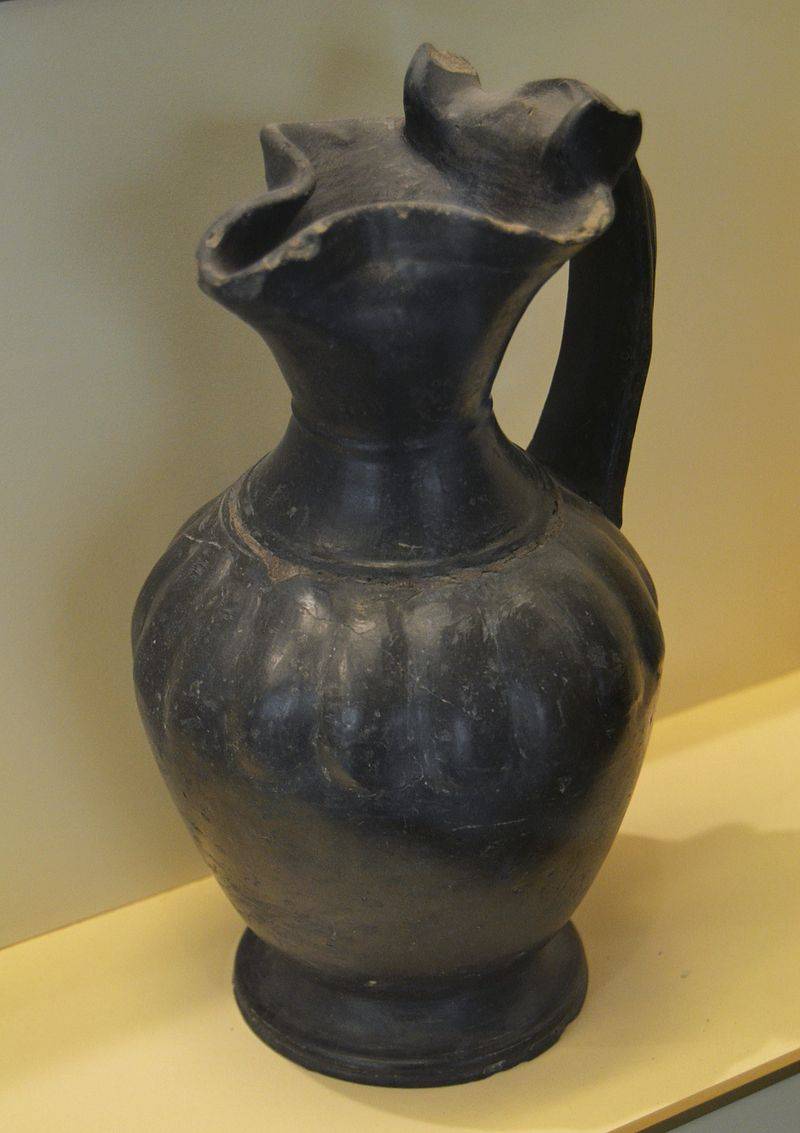
Another Etruscan ceramic oinhoja. (Museum of Ceramics, Valencia, Spain)
Reconstruction of the burial chamber. (Museum in Chatillon-sur-Seine, Burgundy, France)
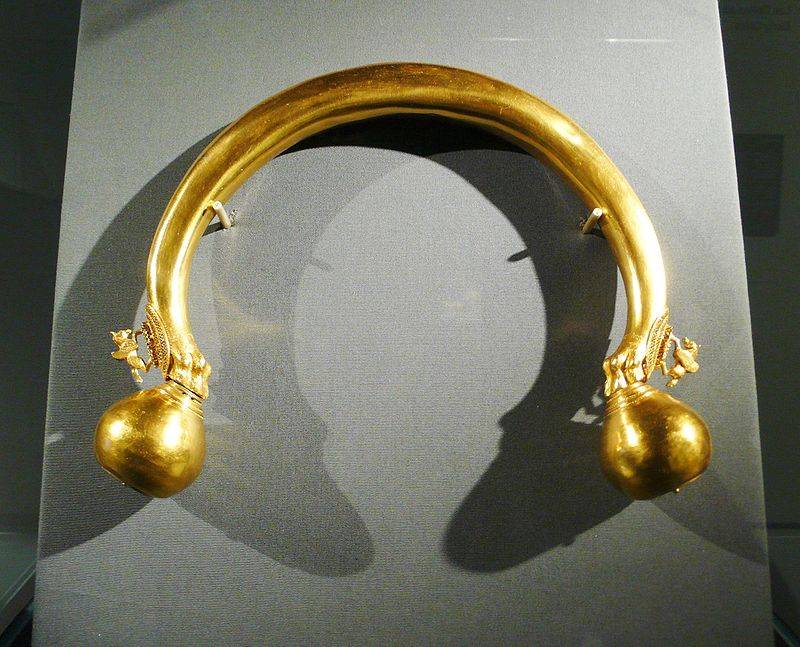
Golden hryvnia with pegasus figures. (Museum in Chatillon-sur-Seine, Burgundy, France)
As for the famous 1.63 m crater in height, it is necessary to tell about it especially. To begin with, its own weight is more than 200 kg. The crater of the Greeks is a vessel designed to mix wine with water at a feast, because the Greeks did not drink undiluted wine. But usually the craters were made of clay. The crater from Viks was, firstly, very large, and secondly - metal. It was made from more than seven separate parts that had alphabetic markings, which tells us that it was delivered to Burgundy in a disassembled form (and really drag this enormous and heavy pleasure below average!), And already here, on the spot, collected from them a vessel. The container itself was made of chased bronze sheet. Her weight is about 60 kg. The bottom is rounded, the maximum diameter of 1,27 m, while its volume is equal to 1100 liters. Moreover, the work is very thin in the truest sense of the word, because the thickness of the crater walls is only from 1 mm to 1,3 mm. That is why they found him in a crushed form, that is, he could not bear the weight of the mound above him. So then it had to be restored, which was a very difficult task. Legs are metal, cast, weight 20.2 kg. The crater handles are very massive and weigh about kg each. They depict the faces of Medusa Gorgon, and on the rim of the crater there is a frieze depicting hoplites in armor. It is made in the form of a bronze ring, attached to the crater, and to which handles are attached. The frieze shows eight chariots harnessed by four horses. Each chariot with a charioteer is accompanied by one armed hoplite. The cover is made of bronze sheet, has a weight of 46 kg. Today, this crater is considered the largest among the famous Greek bronze vessels. And where did they find him? In Burgundy !!! Most likely it was a gift that somehow had to do with winemaking. Unfortunately, history This crater, perhaps in its own way completely unique, we will never know.
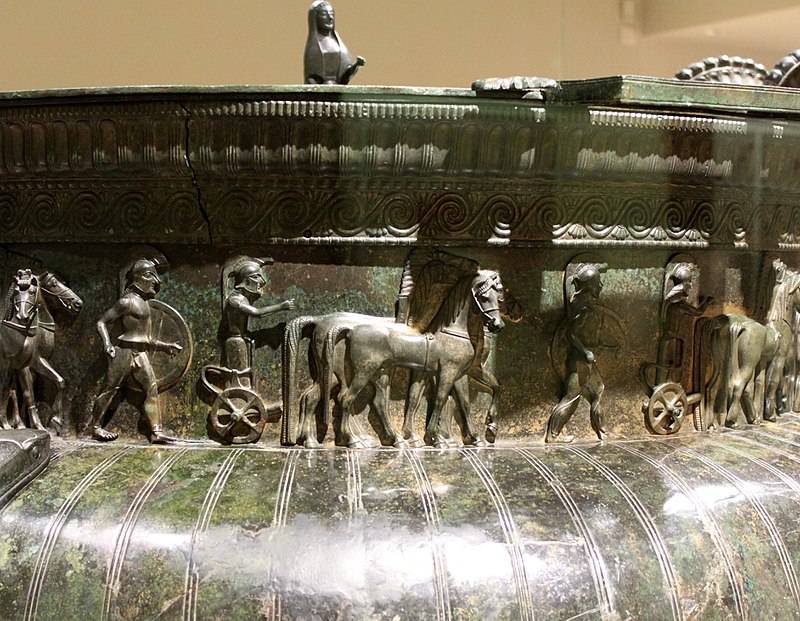
"Crater from Vicks" very accurately conveys the appearance of warriors and chariots of that era. (Museum in Chatillon-sur-Seine, Burgundy, France)
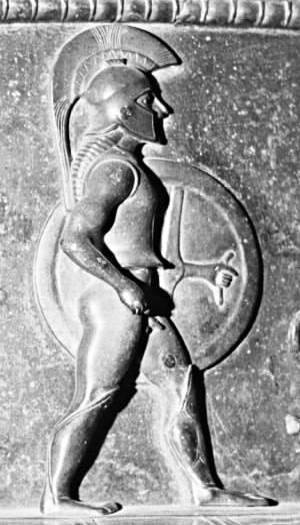
Spartan warrior in the frieze from the crater.
In addition to the female burial in “Kurgan I”, as many as five large burial mounds were discovered there and three of them were excavated. “Barrow II” was also not small - 33 m in diameter. An urn with cremated remains was also found in the mound, but the dating is different - 850 BC. er In the second mound, they also found the remains of a woman, as well as a chariot (or rather, what was left of her!), On two axes of iron and ... another gold bracelet. In the third mound, destroyed in 1846, there was again a cart, and also an Etruscan bronze bowl with four handles and images of griffins. Here, in 1994, fragments of two statues were found - a warrior and a woman, made of stone and surrounded by a small fence. What could all this mean ... nobody knows.
Mound from Hochdorf.
The same mound view from a height.
However, the value of these finds is already very large. First of all, it speaks of a pronounced stratification in La Tene society. There were buried here "princesses" or "princes" in the sense that today we understand these two terms - it is not known and discussed. In any case, the comparison is obvious: there is a sharp contrast with the previous era, in which all the burials are similar to one another. Moreover, similar necropolises of the same time as Weeks exist in other places. These are fortified villages found in Heineburg and Glauberg. And here we see the same thing. That is, there was a new social class, which, when buried, received complex and costly mounds in construction, gold jewelry that was not found in ordinary graves, “expensive imports” (the same Spartan crater), and even amber beads.
Reconstruction of the burial chamber "Hohdorsky leader." (Burial Museum in Hochdorf, Germany)
A similar burial, only for men, the burial of the "prince", dated approximately 530 BC. e., found an amateur archaeologist in Germany at 1977 near the village of Hochdorf an der Enz, belonging to the municipality of Eberdingen, in the federal state of Baden-Württemberg. The height of the mound - 6 m, diameter - 40. But such, as it was determined, were its original dimensions. And by the time of excavation, due to soil erosion, its height dropped to one meter. The burial of the “Hochdorf leader” is considered to be the tomb of the “Celtic Tutankhamen” and this is not an exaggeration.
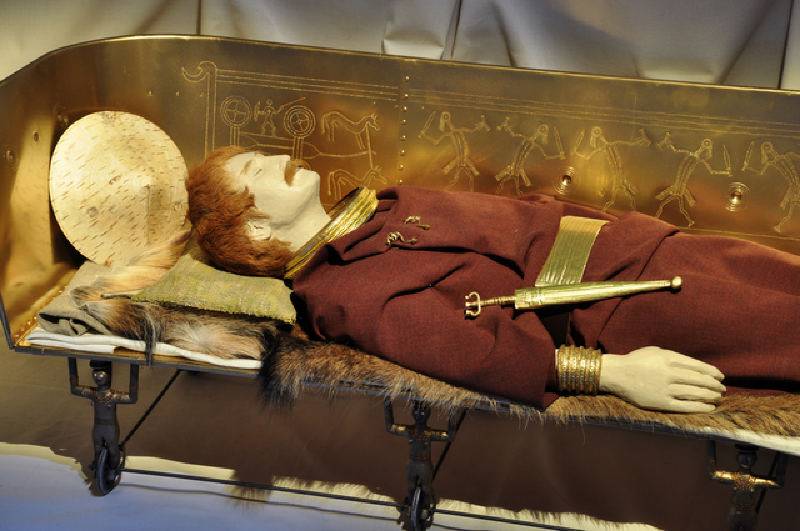
Here it is ... it was "handsome." Mustache let go, but also with a hat! (Burial Museum in Hochdorf, Germany)
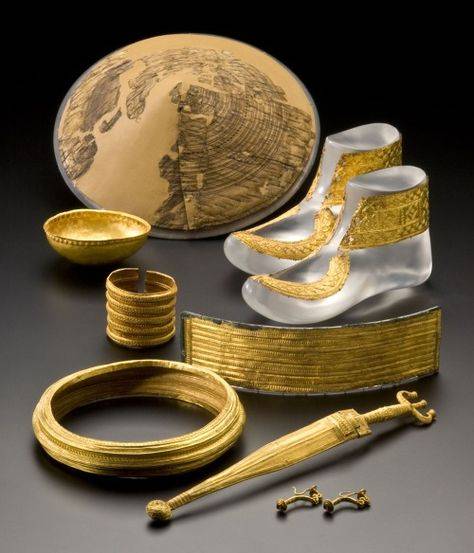
And these are his funeral gifts!
The deceased was a man of about 40 years old, and the height of 178 cm (according to other data - 187 cm). He did not lie in a coffin, and was not burned, but was laid on a graceful bronze bed, like a sofa or a garden bench, in 275 cm long. He was clearly a Celtic leader, since he did not regret the gold jewelry in the afterlife. Among the jewelry was a gold neck hryvnia and a bracelet worn on the right hand, and it was also provided with amber jewelry. On his head was a conical (well, perfectly Vietnamese!) Hat made of birch bark, although he himself was wearing rich clothes. There were two daggers with a length of 42 cm with blades of iron and bronze, in golden sheaths and gilded handles.
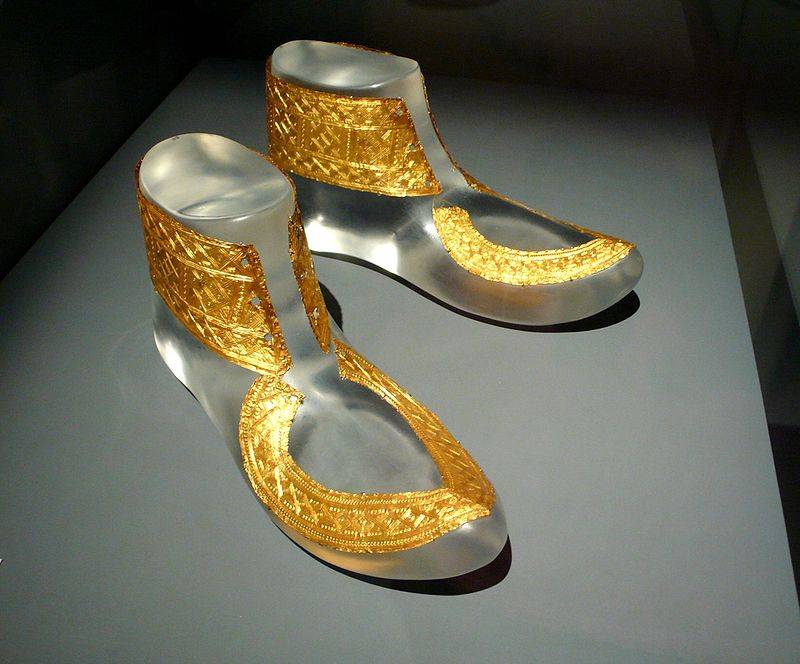
Very unusually decorated shoes, is not it?
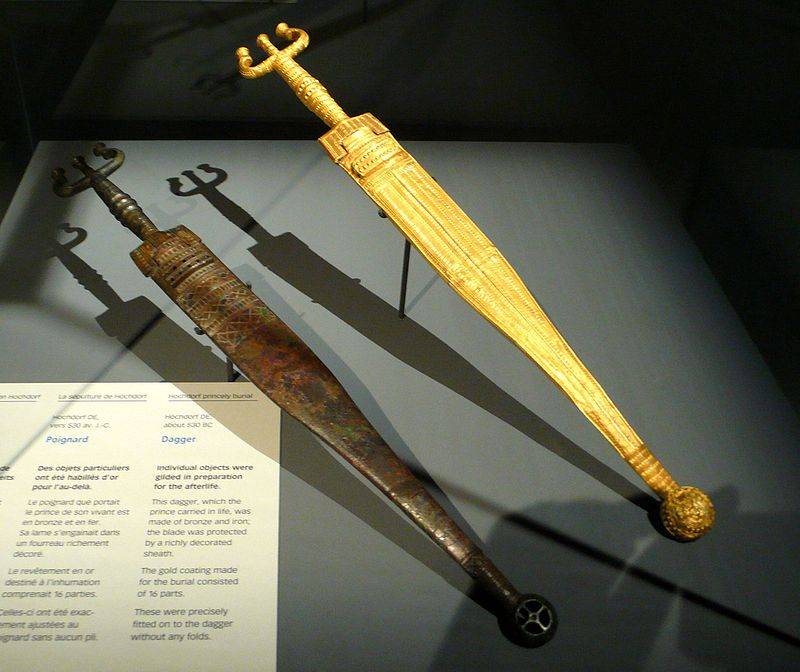
Daggers: one bronze, the other "golden", or rather, in the golden sheath.
Horn for drinking.
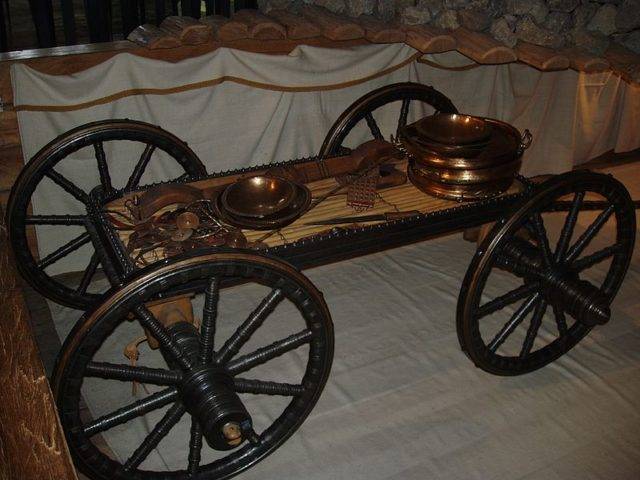
And this is a cart with dishes!
But especially unusual look, found here, ornamented plates of gold leaf, adorned his shoes. They also found a large cauldron near the bed, in which at the time of burial there was ... 400 liters of honey. In addition, the burial again turned out to be a four-wheeled wagon, which was packed with an impressive set of bronze dishes, including drinking horns designed for nine people.
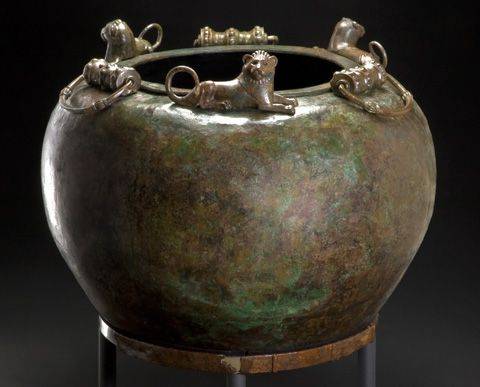
There he was what - a pot of 400 liters of honey!
After the burial was studied, the mound was filled to its original height and diameter, and a museum was built nearby. Moreover, when digging a foundation pit under its foundation, they also found the remains of a Celtic village, which, apparently, was “led” by this “leader”. In the museum you can see the preserved skeleton of the deceased and all objects found in the burial chamber, some of which were restored. That is, having been in it, you can see exactly how this burial looked at the time of its laying.
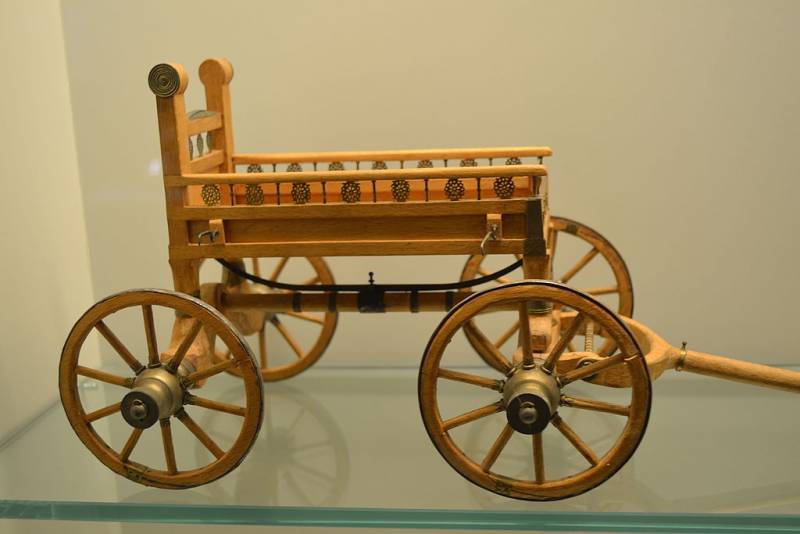
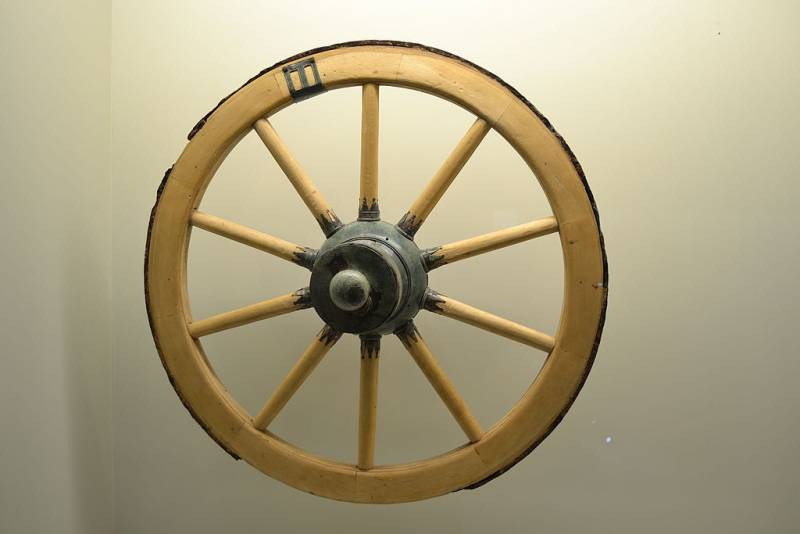
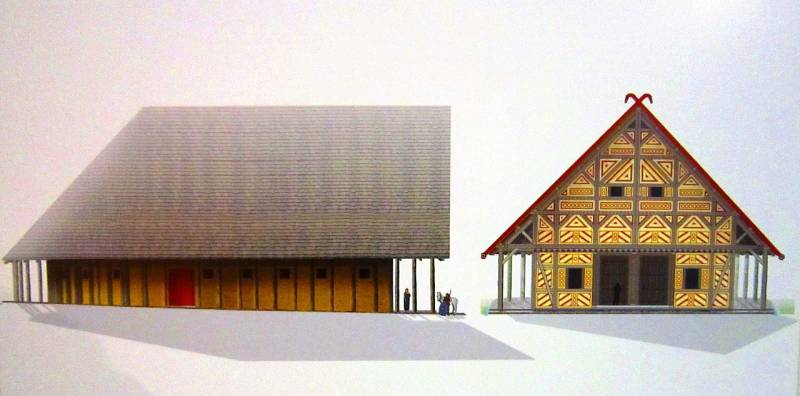
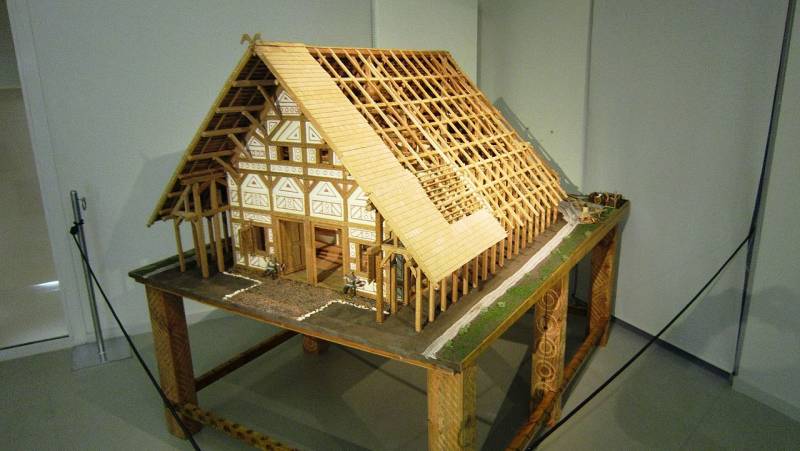
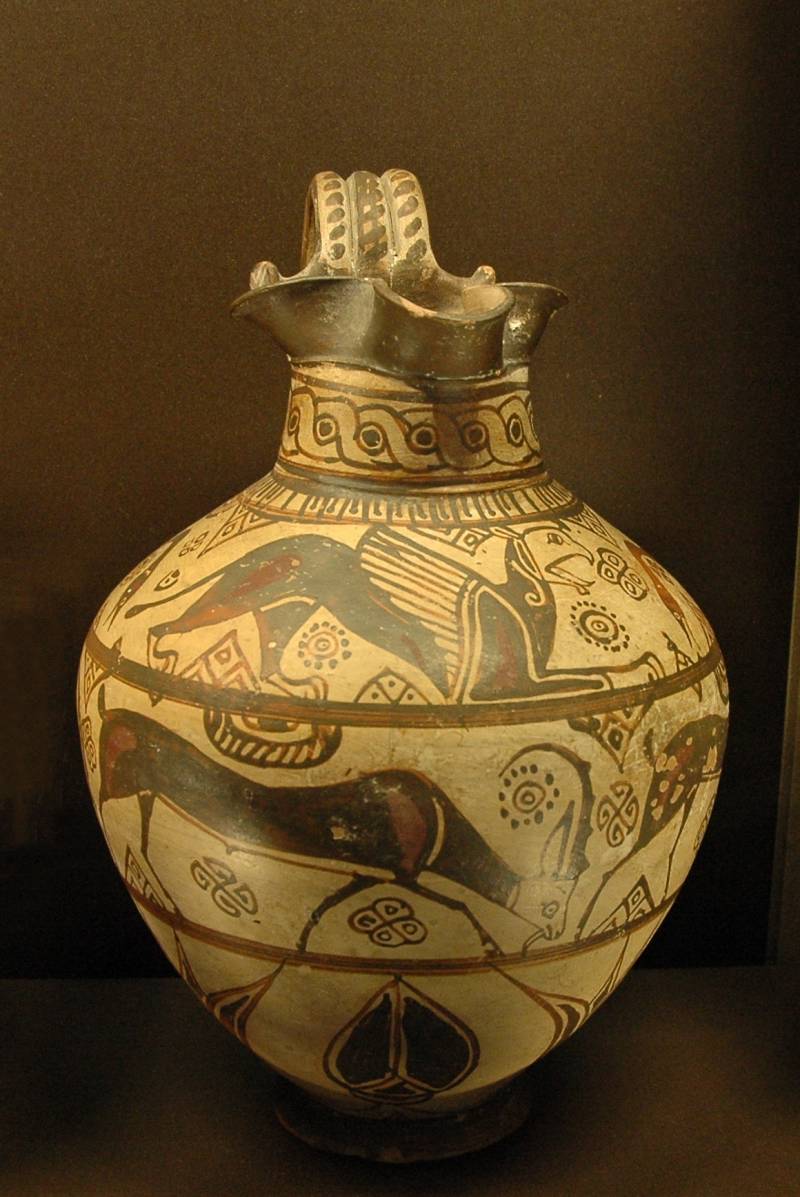
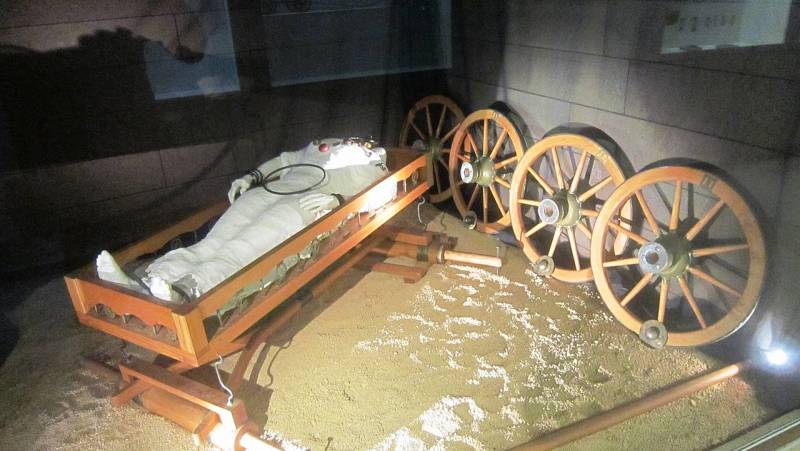
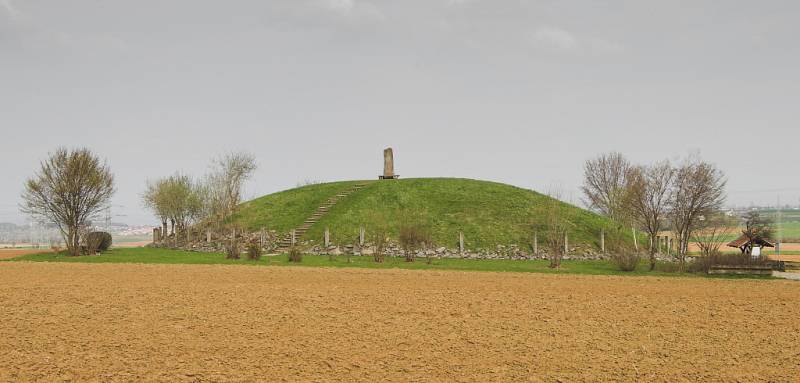
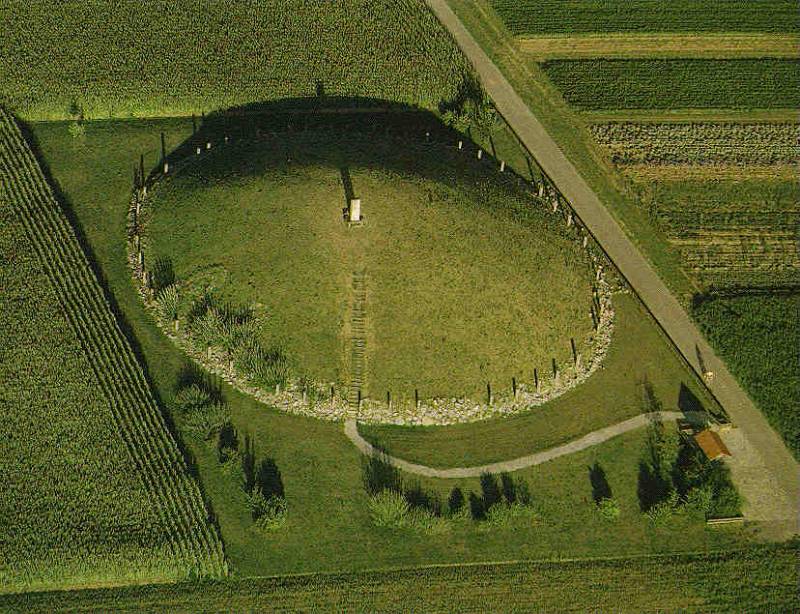
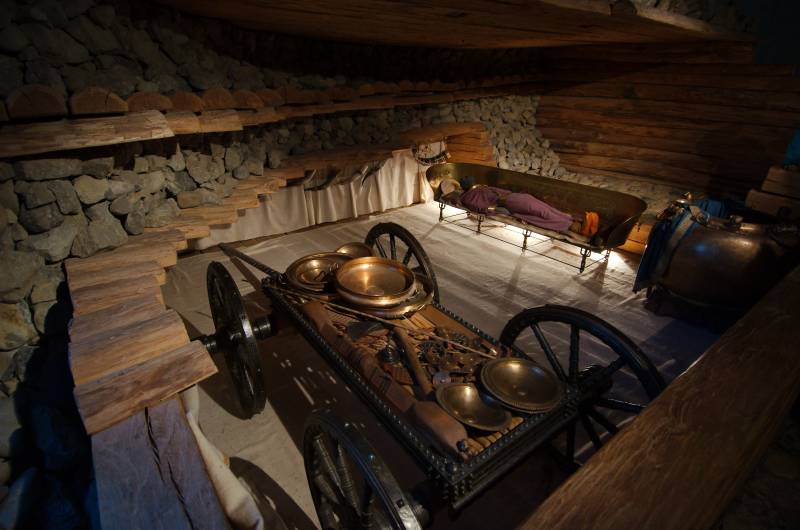
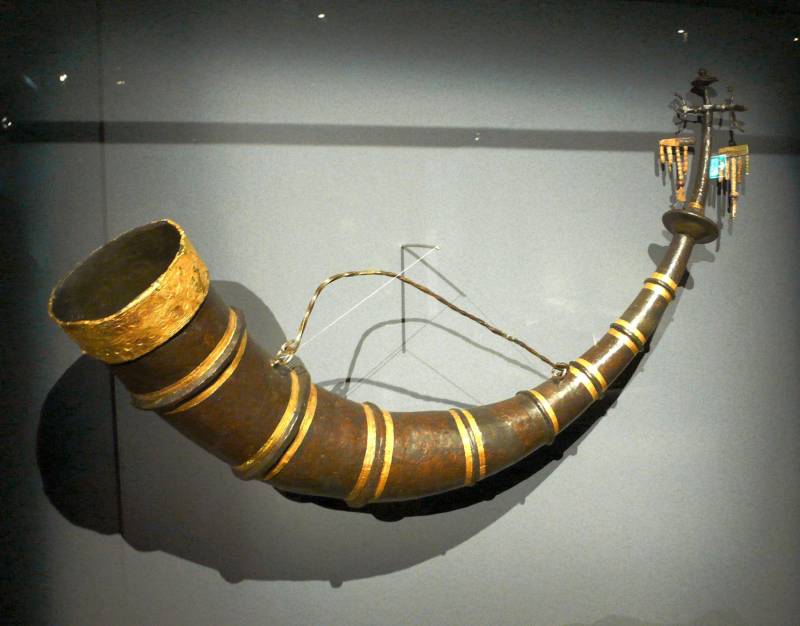
Information